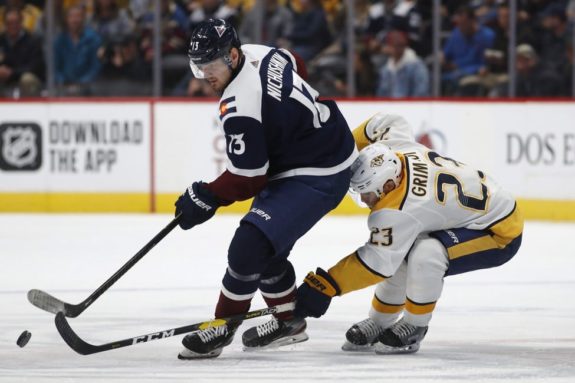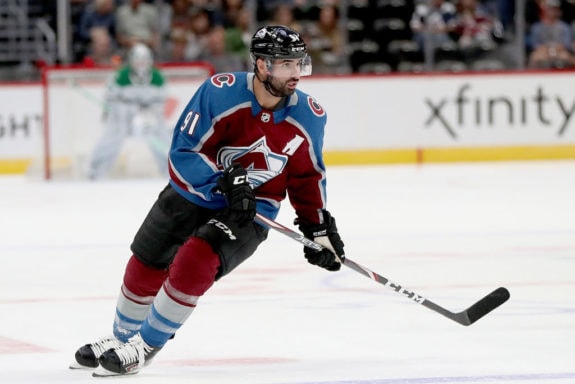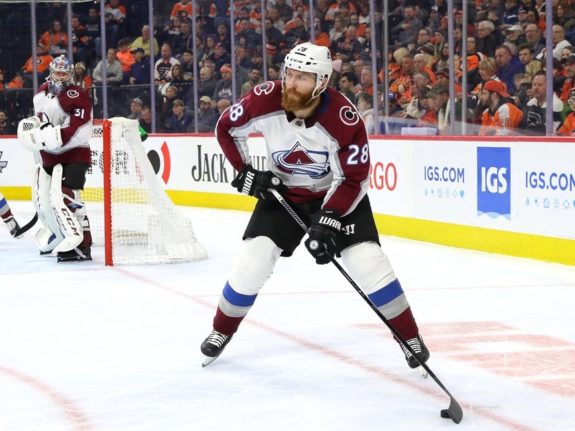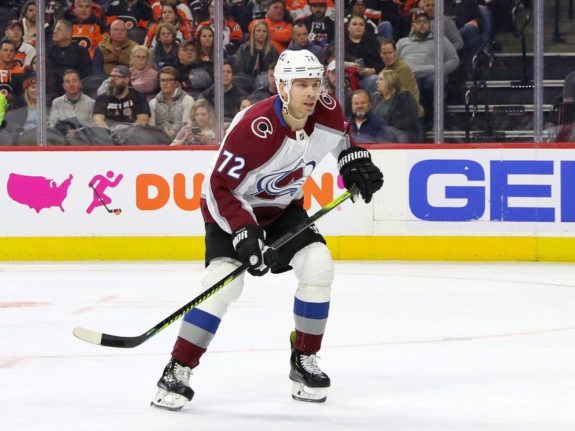The Colorado Avalanche experienced several high-profile injuries during the 2019-20 season. A fully healthy squad should make a deep run in the playoffs, and expectations couldn’t be higher. All eyes will be on Nate MacKinnon to lead the club back to the Stanley Cup Final, but there are several nuances to the Avalanche system that are also incredibly important.
There were many other facets that I explored here, like face-off wins, penalty killing, and power-play success. But I thought that those talking points already received a fair amount of mainstream coverage. The purpose of this article is to bring awareness for overlooked aspects of the game, and use advanced metrics to defend their importance. As always, please let me know in the comments what I got wrong.
Strong Defensive Forwards
One of the most overlooked features of the Avs’ high-octane offense is how mission critical the forwards’ defensive play is. Bednar’s system requires forwards to initiate defense to assist the blue liners in keeping the puck out of the middle and forcing low-quality shots from specific areas.
Related: Colorado Avalanche Franchise Jersey History
A good way to measure this is by using expected goals (xG), which calculates the number of goals scored on unblocked shots. It’s used to measure the effectiveness of a player when he’s on or off the ice and compares it to the league average.
The team has several players with excellent xG stats sprinkled throughout the lineup. Valeri Nichushkin is the best defensive forward by xG. Compared to when he’s not on the ice, the Avalanche prevented 24% more goals than the league average. Pierre-Edouard Bellemare (13%), Tyson Jost (12%), and J.T. Compher (11%) round out the double-digit defensive play drivers. It wasn’t just the role players who produced on defense; Gabriel Landeskog was the third-best forward defensively based on Goals Against Replacement (GAR).

Strong defensive forwards are important in the playoffs because their two-way value means that they will log major minutes in a variety of situations. That’ll provide more rest to the Avs’ stars, and the mixing of lines will keep our opponents guessing as to who they’ll face on the ice. Additionally, scoring depth is a huge advantage in the playoffs because it thins the opponents’ defensive assignments away from the normal top-scoring players, which is difficult for many teams to adapt to.
Scoring Depth
With all the injuries that the Avalanche accumulated this season, the club needed diversified scoring to remain at the top of the tables. MacKinnon played Hart Trophy-level hockey, but so many players stepped up in the face of adversity, too. This bodes well for the team in the playoffs because our depth will again face calls to produce offensively.
The further we advance in the playoffs, the more teams we’ll face who have stud players on their top scoring lines. It’s not a blueprint for postseason success to rely solely on a few goal scorers. The extended 24-team playoff format places more importance on scoring depth, evidenced by recent Cup winners.
Related: Little Known Facts About the Stanley Cup
Outside of the top line, Andre Burakovsky, Nazem Kadri, Joonas Donskoi, and Compher are the skaters from whom we need scoring. All four contribute negatively on defense, and two of them – Compher and Donskoi – had negative total xG, meaning that the team was better with them on the bench than on the ice.

Kadri and Burakovsky will man the second scoring line and the second power-play unit, so expectations for them will be higher. Matt Calvert and Compher were scoring at or near career-high paces when hit by the injury bug. I have low confidence in Donskoi’s efficacy while on the ice, but he can contribute in a special way off of it.
Locker Room Leadership
I suspect that the Avs already know that Donskoi was a major liability this season. I’d be surprised to see him log ice-time in critical situations or on a scoring line, especially now that nearly everyone is healthy. However, he has played in 50 career playoff games, and he did score the series-winning goal against the Avs during last season’s Western Conference Semifinal, so he has quality experience from which to draw.
There’s value in team unity and general manager Joe Sakic has noted that that’s been an important part of this season’s success and part of his trade deadline strategy. But Donskoi was arguably the worst-performing forward on the team this season, and should receive playoff minutes to mirror that.

Also, Ian Cole, Philipp Grubauer, and Burakovsky are three veterans who have special playoff experience. They’re the only skaters to have won the Cup; Cole won it in during the 2015-16 & 2016-2017 seasons with the Pittsburgh Penguins, and Burakovsky and Grubauer were on the Stanley Cup Champion Washington Capitals squad in 2018. Cole has been especially vocal about what the team’s mindset needs to be to win the Cup:
Anything short of that is a failure and that’s the attitude you need to have every single year. It can’t be, ‘Oh, well, let’s just get into the playoffs and we’ll see how it goes. No, (expletive) that. It’s, ‘No, we want to win a (expletive) Stanley Cup. Every single (expletive) year. This year, next year, the year after that, 10 years down the road.’
Injury Mitigation via Physical Intimidation
With the addition of 6-foot-5 Ryan Graves, the Avalanche have a bruising defenseman in each of the three top defensive pairings: Ryan Graves with Cale Makar, Erik Johnson with Sami Girard, and Nikita Zadorov with Ian Cole. Zadorov is a special, thunderous presence on the ice that will set the stage for how opponents should treat his team. His defensive contribution waned this season, but he led the team with 175 hits in 64 games.
His physical intimidation plays a part in protecting MacKinnon & Co. against targeting and limits the effectiveness of opponents’ intensity. His value is that he controls how forceful the other team can play against us, because nobody on the other bench will want to draw the ire of Zadorov. Even slightly less intensity from our opponents could lead to a more controlled game, and therefore fewer accidental injuries.

I understand the counterpoint to this argument; having these players didn’t prevent injuries before the playoffs. I think having consistent and less varied assignments will provide our big defensemen more focus on protecting our scorers.
Addition by Subtraction
I’ve been sharply critical of Donskoi’s failures this season, so it pains me to say that we need him in a leadership role this postseason. However, for the Avs to succeed, he should only earn his keep in the locker room and not on the ice. We saw the Boston Bruins last season do something very similar in the Stanley Cup Final.
Related: The Ice Rink – A Brief History
The Bruins benched former St. Louis Blues captain David Backes for Games 5-7 because of ineffectiveness. They fielded the best team possible, and didn’t care about the nostalgia of inserting Backes into the lineup against his former team. Kyle Cantlon of Yahoo Canada Sports broke it down at the time:
His physical contributions and leadership qualities have been admirable as he’s been able to carve out a role that has been useful for the Bruins at times, but with every goal, scoring chance and shot generated being of absolute critical importance with the final series of the season winding down, he’s been deemed obsolete when it matters most.
Donskoi has had the exact opposite effect on the ice that he was brought in to do. He was billed as a second-line right-winger with defensive ability, but what he produced this season was anything but. When Mikko Rantanen and Landeskog returned from injury in December, Donskoi was re-assigned from the top line. He scored 11 points in the 39 games after November, and was the worst defensive skater on the team.

On defense at even-strength, opponents were expected to score 21% more than league average on unblocked shots when Donskoi was on the ice. When he wasn’t on the ice, opponents’ expected goals were 12% below average. He had a career low in Corsi (47.9), but his Corsi relative to the rest of the team was minus-4.7. This means that his team faced 4.7 more shots per game when he was on the ice versus when he wasn’t. Put another way, his absence was a big positive for the team.
Endless Colorado Summer
As a top-four seeded team in the West, Colorado is facing off in a round robin against the Blues, Dallas Stars, and the Vegas Golden Knights to determine playoff seeds 1-4. At least on paper, our roster is a favorite to win the Cup. The time off has healed many of our infirmed, but the Avalanche may look rusty in the beginning. Calibrating offensive timing takes time after layovers, which is why the nuances mentioned in this article are vital. Each one by itself is not enough to propel any team deep into the postseason, but combined with our scoring potential, they’ll make us a very difficult team to beat, especially if we win the first seed.